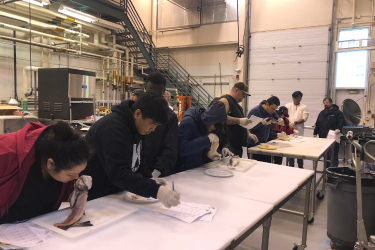Today we’re interviewing Louisiana’s amazing wetlands in the Gulf of Mexico. Thanks for being here for Habitat Month!
Wouldn’t miss it for the world!
Can you tell us a little bit about your history, and how you got where you are today?
It’s been a real roller coaster, honestly. I originally formed when the Mississippi River deposited soil and sediment near the ocean. Over time, plants took root in my soil and I formed my own little ecosystem.
Through the years, my marshes have been through a lot—things like land loss, sea level rise, hurricanes, and oil spills have led to a lot of them disappearing at a pretty high rate. Recently, though, I’ve gotten quite a bit of help rebuilding some of my most valuable barrier islands and marshland. Currently, I make up more than 40 percent of America’s coastal wetlands!

What is a day in the life like as a salt marsh?
I’m a really busy habitat with a lot of responsibilities! Besides caring for so many species of birds and fish, I go through an intense daily cleaning session—I filter toxins and pollutants out of the water through my spongy soil, and absorb tons of carbon dioxide and other greenhouse gases. I also divert tides and floodwaters to keep them away from the people and animals inland. It’s tough and muddy work, but someone’s gotta do it.
What are your strengths and weaknesses?
I’m really good at calming down a tense situation. When storms come up, I always step in the middle of a conflict and absorb all that dangerous energy; I’m able to protect communities from up to 20 percent of storm damage. People always say they’d definitely want me on their side in a hurricane!
On the other hand, I tend to let things pile up, and then get swamped whenever the water rises too high. Climate change has already flooded a ton of my wetlands, and even though I’m working overtime to protect coastal communities, I sometimes don’t know how much more stress I can take!
Can you tell us about a recent challenge you overcame?
Recently, I’ve been losing a lot of my barrier islands due to erosion, rising tides, and other factors like oil spills. My islands are important because they keep my marshlands from flooding. It was pretty hairy for a while, but since the Coastal Wetlands Planning, Protection and Restoration Act was enacted in 1990, my friends at NOAA have been helping build up and restore my dunes.
To do this, they dredge sediment from the Mississippi or out in the ocean and pump it into the dunes to create salt marshes and terraces. Then, they plant some of my native plant species to help hold it together. It’s been great to see my favorite birds come back to nest on the island, and thanks to this natural infrastructure, I can sleep peacefully at night knowing a storm isn’t going to wash away the whole coast.
Check out some of my beautiful before and after photos, courtesy of NOAA’s Restoration Center:




A lot of my support comes from the State of Louisiana, especially the Coastal Protection and Restoration Authority and the Oil Spill Coordinator’s Office. I also work really closely with the NOAA and the rest of the Louisiana Trustee Implementation Group through the Deepwater Horizon restoration program. I can’t thank them enough for always building me up when I’m sinking down!
Where do you see yourself in 5 years?
I’m all about goal-setting. Some folks have a 5-year plan—mine is more like a 50-year plan. The Louisiana Coastal Protection and Restoration Authority is helping me prepare for my future with their Coastal Master Plan. The current version outlines projects that will help me build or maintain 800 square miles of land over the next 50 years. Just think how many communities I can protect with all that extra marsh-power!
My friends are also great about keeping me on track. Each year, we pull together an annual plan—almost like an annual performance plan you might have at your own job—to keep an eye on our work toward the Coastal Master Plan. And we make sure to adaptively manage the goals in the Master Plan, too: In 2023, we’ll have an updated Coastal Master Plan that uses the best data available to help us achieve our goals.

What other habitats do you admire?
We may be on opposite sides of the country, but I’m so impressed by the wetlands near Muskegon Lake in Michigan. Talk about a makeover!
Life was pretty stressful for Muskegon Lake over the years, with environmental challenges like loss of wetlands, untreated sewage, and contamination from pollutants like heavy metals and polychlorinated biphenyls. In 1987, Muskegon Lake was listed as one of 43 degraded industrial areas known as Great Lakes Areas of Concern.
But recently, Muskegon Lake has been working hard to turn things around! Through the Great Lakes Restoration Initiative, NOAA and partners are helping restore Muskegon Lake and other Areas of Concern. NOAA even named Muskegon Lake one of its Habitat Focus Areas, bringing special attention to its recovery. It’s been so inspiring to watch Muskegon’s recovery from afar!



